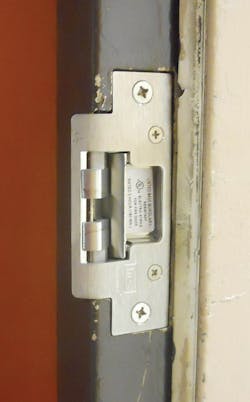Conventional electric strikes require cutting out a portion of the doorjamb to allow the latchbolt in the extended condition to exit the keeper, permitting the door to swing open. This visible portion of the conventional electric strike can detract from the overall appearance of an opening. The amount of material removed from the doorjamb to accommodate the electric strike depends upon the size of the electric strike body, faceplate and the design of the keeper.
Equipping an outswinging exterior door with a conventional electric strike exposes the keeper and the release mechanism, detracting from the aesthetics. Another downside of installing a conventional electric strike onto an outswing exterior door is the keeper mechanism is exposed to the elements, including those wishing to gain unauthorized access. For some applications, a latch protector can be installed, covering the electric strike and providing protection against unauthorized access.
Over the last several years, a number of electric strike manufacturers have introduced their versions of the "No Cut" centerline latch electric strike. Although the overall design of the "No Cut" electric strikes vary, the basic concept is no keeper cutout in the doorjamb is necessary in order to remotely release the door. Depending upon the make and model, "No Cut" electric strikes can accommodate cylindrical lock latchbolts and centerline mortise lock latchbolts having a ½" or 5/8" throw. Some "No Cut" electric strikes are designed to fit within the doorjamb strike box.
The most common application for a "No Cut" electric strike is replacing the ASA strike plate used in hollow metal ANSI prepped doorjambs in order to remotely release a cylindrical lock. The ASA strike plate is 4-7/8" tall by1-1/4” wide and normally has a lip 3-3/8” tall that allows the latchbolt to retract into the centrally located strike opening without marring the jamb.
To accommodate different doorjamb configurations, some electric strike manufacturers offer optional faceplates. For example, HES 8000 and 8300 Series electric strikes are available with a choice of three ASA faceplate options: the standard 4-7/8" by 1-1/4" faceplate, a radiused version and an extended lip version for "knock-down" style doorjambs.
The "No Cut" electric strike operates very much like a standard electric strike. As the door is closed, the latchbolt and the deadlatch slide into the pocket as they slide over the faceplate lip. The keeper is in the extended position, keeps the deadlatch retracted, not allowing the latchbolt to be retracted permitting the door to swing open. With the door in the closed position, the deadlatch remain retracted.
To accommodate the "No Cut" release mechanism, electric strike manufacturers needed to develop a method to release the deadlatch in order to push the latchbolt back into the latch body. Once the deadlatch is fully extended, the deadlatch and latchbolt can be pushed into the latch body in order to open the door. When released, each electric strike manufacturer’s "No Cut" keeper permits the deadlatch to fully extend. To complete the operation, the "No Cut" electric strike pocket is designed to enable the deadlatch and latchbolt to retract simultaneously as the door swings open.
To accomplish this, the keeper must be positioned within the "No Cut" electric strike pocket. The body had to be redesigned to fit within the confines of the ASA strike opening in the doorjamb. In addition, many doorjambs are equipped with a strike box. The BEA "No Cut Cylindrical Strike" has a body that is less than one inch deep in order to leave the strike box within the doorjamb unmodified. The average reinforced doorjamb has an integral mortar guard box sized to take up to 1” long latch or deadbolts.
Some manufacturers advertise that no frame or strike box cutting is required in standard ANSI prep doorjambs. Other manufacturers indicate there is no modification to the face of the doorjamb. Remember that not every doorjamb is standard.
Important: When installing a "No Cut" electric strike, make certain the deadlatch is in the correct position for smooth operation. If the door does not close and latch easily and smoothly, under the power of a properly adjusted door closer, make whatever repairs and adjustments necessary prior to the installation of the electric strike to insure smooth operation.
Because the alignment is important for a "No Cut" electric strike, some manufacturers offer vertical and horizontal faceplate adjustment. Many "No Cut" electric strikes have a vertically adjustable "ramp." The "ramp" can have a cutout through which the deadlatch slides. The adjustable "ramp" determines the top and bottom positioning the electric strike can accommodate the latchbolt. The deadlatch passes through the cutout in the ramp when the door is opened and closed. The deadlatch must not contact the ramp when the door is opened or closed. The Rutherford Controls 5 Series "No Cut" electric strike has vertical adjustability of up to 5/16".
The horizontal adjustment is used to position the deadlatch directly above the keeper to insure the lock remains locked until the keeper is retracted.
When the keeper is released, the deadlatch extends into the electric strike pocket. To push the deadlatch and the latchbolt simultaneously into the latch body, the "No Cut" Electric Strike utilizes an internal ramp. As the door opens, they slide higher up the ramp compressing them into the latch body. Opening the door provides a similar operation to rotating the lock's knob or lever.
"No Cut" electric strikes are available in different configurations including 12 and/or 24VDC, Fail Safe and/or Fail Secure and ANSI/BHMA A156.31 Grade 1, 2 or 3. Some are available Fire Rated and/or UL 1034 burglary-resistant listed. The Camden 20 Series "No Cut" electric strikes have pre load in Fail Secure models that range from 20 pounds to 65 pounds.
Before purchasing a "No Cut", electric strike, be sure to read the printed material to determine exactly what features satisfy your customers requirements.
Important: Always discuss an electronic installation with the local authority having jurisdiction (LAHJ) prior to installing.
For more information, contact your local locksmith distributor or the following manufacturers of No Cut Electric Strikes.
BEA, Telephone: 800 523 2462. Web Site: www.beainc.com/BEAINC/products/security/NCstrikes.php.
Camden Door Controls, Telephone: 877-226-3369. Web Site: www.camdencontrols.com
Effeff, Telephone: 407-447-9506. Web Site: http://www.effeff.com/site/effeff/effeff-USA/
HES, Telephone: 623-582-4626. Web Site: www.hesinnovations.com
RCI, Telephone: 800-265-6630. Web Site: www.rutherfordcontrols.com/en/products/electric-strikes/5-series/
About the Author

